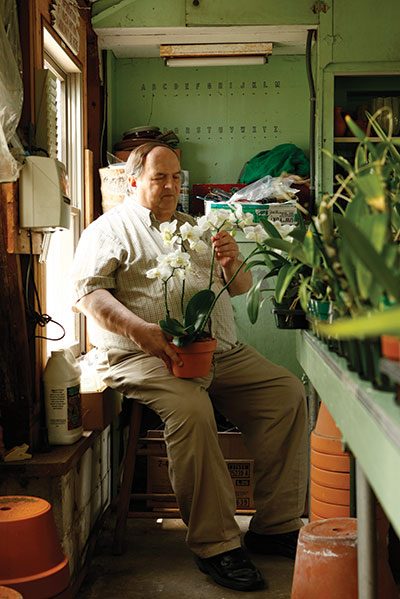
Walter Off spends at least an hour every day answering calls about how to nurture orchids: Is my plant getting too much light? When do I have to repot?
Though each species is highly alluring to its respective pollinating insects, humans, too, often find themselves drawn in. Passion tends to develop into expertise, but to understand all the nuances of caring for these fussy blooms, many turn to Waldor Orchids, where growing is a skill cultivated over three generations.
“We’re looking for people who really love orchids,” Walter Off says one recent morning at Waldor’s greenhouses, tucked away at the east end of Poplar Avenue in the Atlantic County town of Linwood. Waldor’s seven greenhouses cover 18,000 square feet, making Waldor the largest commercial orchid grower in the state.
It’s also the oldest, with a first incarnation in 1925 as Brighton Florist, founded by Walter’s father, George Off. Through time and experience, Waldor has earned a shining reputation among serious gardeners and florists around the Garden State.
“They’re respected in the industry because they’ve been at it a long time,” says Anthony Silva of Silva Orchids in Neptune, the state’s second oldest and second largest hobbyist grower. This, too, is a family business, launched in 1957 by Silva’s father, Augusto Silva.
Waldor supplies and exhibits at prestigious venues like the Philadelphia International Flower Show and Longwood Gardens in Pennsylvania. In fact, the Offs are already busy preparing the centerpiece for next year’s Philadelphia show—a 12,000-square-foot homage to the Hawaiian Islands, one of the best places to grow orchids.
On this morning, one of Waldor’s greenhouses is bursting with Phalaenopsis, also known as the moth orchid for its wide, flat petals that resemble the flying insect. Lanky stems erupt in pink-and-white flowers, some with starburst petals, others with freckles, all with different colored lips jutting out like reptilian tongues.
Phalaenopsis is the heartiest orchid, the genera that beginners are started on, but Waldor is well stocked with more challenging blooms, including Cattleya, the old-time Easter corsage favorite; Paphiopedilum, known as the lady’s slipper (the Asian variety) for its plushy shape; Bulbophyllum, a drippy starfish; Cymbidium; Oncidium; and Laelia—to name just a few.
Frosted panes diffuse the light so the plants, many of which are accustomed to growing under a forest canopy, don’t take a direct hit from the sun. On lower shelves, seeds gestate in small flasks of agar, promising future crops.
Customers come and go, helped by Walter, the chief salesman and business administrator, or his brother William, the greenhouse manager. A third generation of growers is poised to continue the business: Walter’s daughter Amy works in the wholesale and retail operations; his son David helps with growing and handles Internet sales.
In the early days of Brighton Florist, George Off produced a variety of flowers to supply his father’s Atlantic City hotels. It was his way of avoiding a life in the hospitality business. By the 1930s, he had moved almost completely to orchids, building a collection with the help of Thomas Young Orchids in Bound Brook, a now-defunct business that largely stocked South American species.
When he expanded in the 1950s, a promotional deal led Off to take the name of the British company that manufactured the greenhouses: Waldor.
Though the business initially focused on cut flowers—no mid-century mother would go without an Easter corsage—demand eventually grew for potted plants. Waldor worked with Rutgers University to develop the Off Mix, a potting medium chiefly comprised of fir bark that is still used by many orchid growers today.
A large part of the orchid business involves creating hybrids, mixing different genera or species to develop new styles of plant. One of Waldor’s crosses, the Laeliocattleya Elizabeth Off, was awarded the highest honor from the American Orchid Society, the First Class Certificate, in 1961. The orchid was named for George’s wife, who at age 86 still works at Waldor almost every day. Another cross, the Sophrolaeliocattleya Hazel Boyd, once sold as a single plant for $3,000. (More typically, orchids like Phalaenopsis sell for $25 to $30 a plant.)
George’s brother Louis was also a grower, operating a separate business just across the street. He was especially interested in cloning to reproduce plants. In the 1960s, Louis Off traveled to France to master the technique—a skill that came in handy when a virus ravaged the industry about the same time. He was able to clone clean stock, preserving many plants.
David Off is trying to bring back some of those old-time, pre-virus favorites with his Classic Cattleya program. Scouring the country for these antique species, he’s chosen 36 to clone and hopes to eventually clone as many as 100. Waldor will clone 1,000 of each, making available plants that were once “almost endangered,” Walter says. It’s preservation, but it’s also lucrative.
Beyond the profits, growing orchids is clearly a calling for the Offs. “I had my dad’s genes and I just really loved growing,” Walter says. “I would volunteer to pull weeds or wash pots—anything I could do just to be around them.”
His feel for the plants has come from a lifetime of observation, experience he puts to use as a judge for the American Orchid Society, a distinction that requires years of special training. At monthly competitions, he picks the best new hybrids, conferring recognition and a rise in the commercial value of a plant.
When it comes to his own collection though, Walter is reluctant to pick a favorite. He’ll narrow it down to a genus but won’t get more specific: “I have to be careful,” he says. “I’m surrounded by them here.”
Kristina Fiore is a frequent contributor.
Click here to read another story about orchids in New Jersey.
